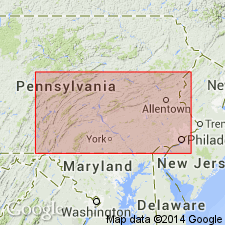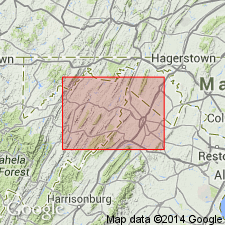
- Usage in publication:
-
- Licking Creek limestone
- Modifications:
-
- Named
- Areal extent
- Overview
- AAPG geologic province:
-
- Appalachian basin
Summary:
Licking Creek limestone, introduced by Swartz (1938: [Abs] GSA Bull., v. 49, no. 12, pt. 2, p. 1923) for a late Helderbergian limestone in south-central Pennsylvania is here more fully described. At base is medium-bedded black chert in irregular layers interbedded with limestone. Above is thick-bedded light-gray crystalline limestone with a few nodules and layers of chert; this is overlain by light-gray limestone with numerous layers of black chert. At top of unit is thick-bedded light-gray chert-free crystalline limestone. Thickness 87 ft in type section where unit underlies Ridgeley formation and overlies beds tentatively considered Mandata shale (new name). Extends southward in narrow belt through MD, WV, and VA. In VA it had been called the Becraft by Swartz (1930).
Source: GNU records (USGS DDS-6; Reston GNULEX).

- Usage in publication:
-
- Licking Creek Limestone*
- Modifications:
-
- Biostratigraphic dating
- AAPG geologic province:
-
- Appalachian basin
Summary:
Conodont biostratigraphy indicates that the Licking Creek Limestone of the Helderberg Group in the Winchester 30 X 60 minute quadrangle is of Early Devonian (Lochkovian and Pragian?) age. Conodonts from the I. WOSCHMIDTI Zone were recovered from the basal 1 meter and conodonts from the E. S. SULCATUS or E. S. KINDLEI Zone were recovered from the upper part.
Source: GNU records (USGS DDS-6; Reston GNULEX).
For more information, please contact Nancy Stamm, Geologic Names Committee Secretary.
Asterisk (*) indicates published by U.S. Geological Survey authors.
"No current usage" (†) implies that a name has been abandoned or has fallen into disuse. Former usage and, if known, replacement name given in parentheses ( ).
Slash (/) indicates name conflicts with nomenclatural guidelines (CSN, 1933; ACSN, 1961, 1970; NACSN, 1983, 2005, 2021). May be explained within brackets ([ ]).

